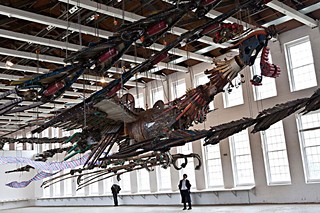All Over Creation: Upscale
Does size matter when it comes to art?
By Robert Faires, Fri., Aug. 16, 2013
What took my breath away at first was simply the size.
Two sculptures were suspended from the ceiling of a two-story gallery, each of which consumed fully a third of the building's 300-foot length. We encounter the monumental every day in modern life – the airliner that ferried me to New England, where I saw these gargantuan creations displayed, was of a like size. But the objects that dwarf us nowadays tend to be mechanical or architectural, and while they might still be impressive, their utilitarian nature has rendered them commonplace. How often, though, do we see a work of art – an object that exists for no purpose other than our contemplation and appreciation – as large as a commercial jet? Rarely enough that taking in their immensity left me flabbergasted. Boggled. Gobsmacked.
Now, as I walked beneath these two representations of the mythical phoenix, hanging so low that my head almost brushed their talons, I found much more to astonish me. Chinese artist Xu Bing built these epic creatures from the detritus of construction projects in Beijing: girders, cement mixer drums, industrial fans, steel rebar, bamboo tubes, fuel canisters, hard hats – any and all manner of waste. The discarded materials recall not only the massive amounts of goods that go into making the colossal buildings and machines that fill our cities, but also the poor, often exploited laborers who make them. And hanging in a space that was for decades part of a huge textile mill, these masses of materials and tools also summon the ghosts of generations of mill workers. At the same time, however, the wildly playful, imaginative ways in which these castoffs have been newly employed in the service of art – shovel heads as feathers, jackhammer drills as beaks – speak to the possibility of rebirth. These scrap-heap behemoths have risen from the ashes of construction sites, much as the Massachusetts Museum of Contemporary Art (aka MASS MoCA) rose from the ashes of the factories that once stood where it does.
Still, I kept coming back to the sculptures' size, imagining how cool it would be to see something that big in Austin, that made your jaw hit the pavement purely because of its ginormity. I think my fixation on that has to do with our city having no real tradition for large-scale art. We've seen examples on occasion – Sally Jacques' grand aerial ballets danced over entire buildings; Jaclyn Pryor's floodlines, sprawling across Hyde Park; Allison Orr's Trash Project and upcoming PowerUP, involving vast spaces and huge machines, and I heard of some locals making a 20-foot-tall animatronic baby head for Burning Man this year – but this has long been a town of modest scale, of storefront theatres and galleries. We've applied our imaginations to limited resources in wonderful ways, but mostly we're miniaturists.
I don't want to change that; I believe in the virtues of the small and cherish the intimacy of the work made here. But Austin is scaling up in so many ways – in the urban towers Downtown, in planned developments like Mueller, in sports arenas and concert venues, in festivals and conferences – and it seems there should be at least one space where our artists can scale up, too, where they can show how they would fill a hall the length of a football field. The thing is, no one is just going to hand us such a space, and spaces here are rapidly being gobbled up for other purposes. It would take a village to secure a MASS MoCA-type venue here, and if it doesn't happen soon, small may be all we ever see.











